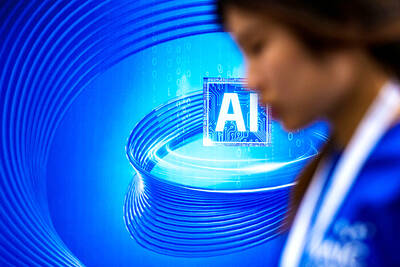Electronic component maker Lite-On Technology Corp (光寶科技) expects revenue to pick up next quarter because demand for Ultrabook computers and servers supporting cloud computing technology is expected to boost demand for its camera modules and power supply units, a company executive said yesterday.
The growth momentum would be even stronger in the second half of this year, helped by an increase in shipments of tablet devices, new smartphones and notebook computers running Microsoft’s upcoming Windows 8 operating system, Lite-On chief executive officer Warren Chen (陳廣中) told a media briefing.
“We have high anticipation for the second half,” Chen said. “We believe Windows 8 will be a major driver.”
Lite-On supplies camera modules and key components to many smartphone makers, including HTC Corp (宏達電) and Nokia.
Chen said a recent -improvement in the US economy and new progress in solving the eurozone’s debt problems gave him greater confidence on growing the company’s revenues this year than three months ago. In December last year, Lite-On said it aimed to expand annual revenues by a single-digit percent this year.
This quarter would be the trough of this year. Revenue is expected to drop by mid-single digits this quarter, from NT$29.07 billion (US$983.32 million) in the fourth quarter because demand usually dips in the first three months of a year, Chen said.
Chen’s forecast beat the expectations of Credit Suisse, which projected a quarterly decline of between 10 and 15 percent this quarter based on a report issued yesterday.
Lite-On yesterday said net income plummeted 31.6 percent to NT$1.5 billion in the final quarter of last year, compared with NT$2.19 billion the previous year, according to the company’s financial statement. That was down 42 percent from NT$2.58 billion in net profits in the third quarter.
The company said a hard disk drive supply crunch after severe floods in Thailand has slowed customers’ PC shipments and thereby curtailed demand for its components. The floods also suspended shipments from its LED factory in Thailand, which caused a decline of 30 percent year-on-year in its LED revenue last quarter.
The floods also cut the company’s gross margin to 12.8 percent in the quarter ending Dec. 31, from 13.1 percent in the third quarter, as manufacturing costs rose, Lite-On said. Gross margin was 12.4 percent in the fourth quarter of 2010.
On Monday, Lite-On posted full year net income of NT$7.23 billion, or NT$3.22 per share, down 19.6 percent from NT$8.99 billion, or NT$4.06 per share, in 2010. Revenues decreased 3.7 percent to NT$118.88 billion last year from NT$123.46 billion in 2010.
Lite-On plans to keep its payout ratio stable at about 72 percent as in prevous years, Chen said.
That would bring its cash dividend to about NT$2.32 per share this year, implying a 6.31 percent dividend yield based on the company’s stock price of NT$36.75 yesterday.

TEMPORARY TRUCE: China has made concessions to ease rare earth trade controls, among others, while Washington holds fire on a 100% tariff on all Chinese goods China is effectively suspending implementation of additional export controls on rare earth metals and terminating investigations targeting US companies in the semiconductor supply chain, the White House announced. The White House on Saturday issued a fact sheet outlining some details of the trade pact agreed to earlier in the week by US President Donald Trump and Chinese President Xi Jinping (習近平) that aimed to ease tensions between the world’s two largest economies. Under the deal, China is to issue general licenses valid for exports of rare earths, gallium, germanium, antimony and graphite “for the benefit of US end users and their suppliers

Dutch chipmaker Nexperia BV’s China unit yesterday said that it had established sufficient inventories of finished goods and works-in-progress, and that its supply chain remained secure and stable after its parent halted wafer supplies. The Dutch company suspended supplies of wafers to its Chinese assembly plant a week ago, calling it “a direct consequence of the local management’s recent failure to comply with the agreed contractual payment terms,” Reuters reported on Friday last week. Its China unit called Nexperia’s suspension “unilateral” and “extremely irresponsible,” adding that the Dutch parent’s claim about contractual payment was “misleading and highly deceptive,” according to a statement

The Chinese government has issued guidance requiring new data center projects that have received any state funds to only use domestically made artificial intelligence (AI) chips, two sources familiar with the matter told Reuters. In recent weeks, Chinese regulatory authorities have ordered such data centers that are less than 30 percent complete to remove all installed foreign chips, or cancel plans to purchase them, while projects in a more advanced stage would be decided on a case-by-case basis, the sources said. The move could represent one of China’s most aggressive steps yet to eliminate foreign technology from its critical infrastructure amid a

Artificial intelligence (AI) giant Nvidia Corp’s most advanced chips would be reserved for US companies and kept out of China and other countries, US President Donald Trump said. During an interview that aired on Sunday on CBS’ 60 Minutes program and in comments to reporters aboard Air Force One, Trump said only US customers should have access to the top-end Blackwell chips offered by Nvidia, the world’s most valuable company by market capitalization. “The most advanced, we will not let anybody have them other than the United States,” he told CBS, echoing remarks made earlier to reporters as he returned to Washington